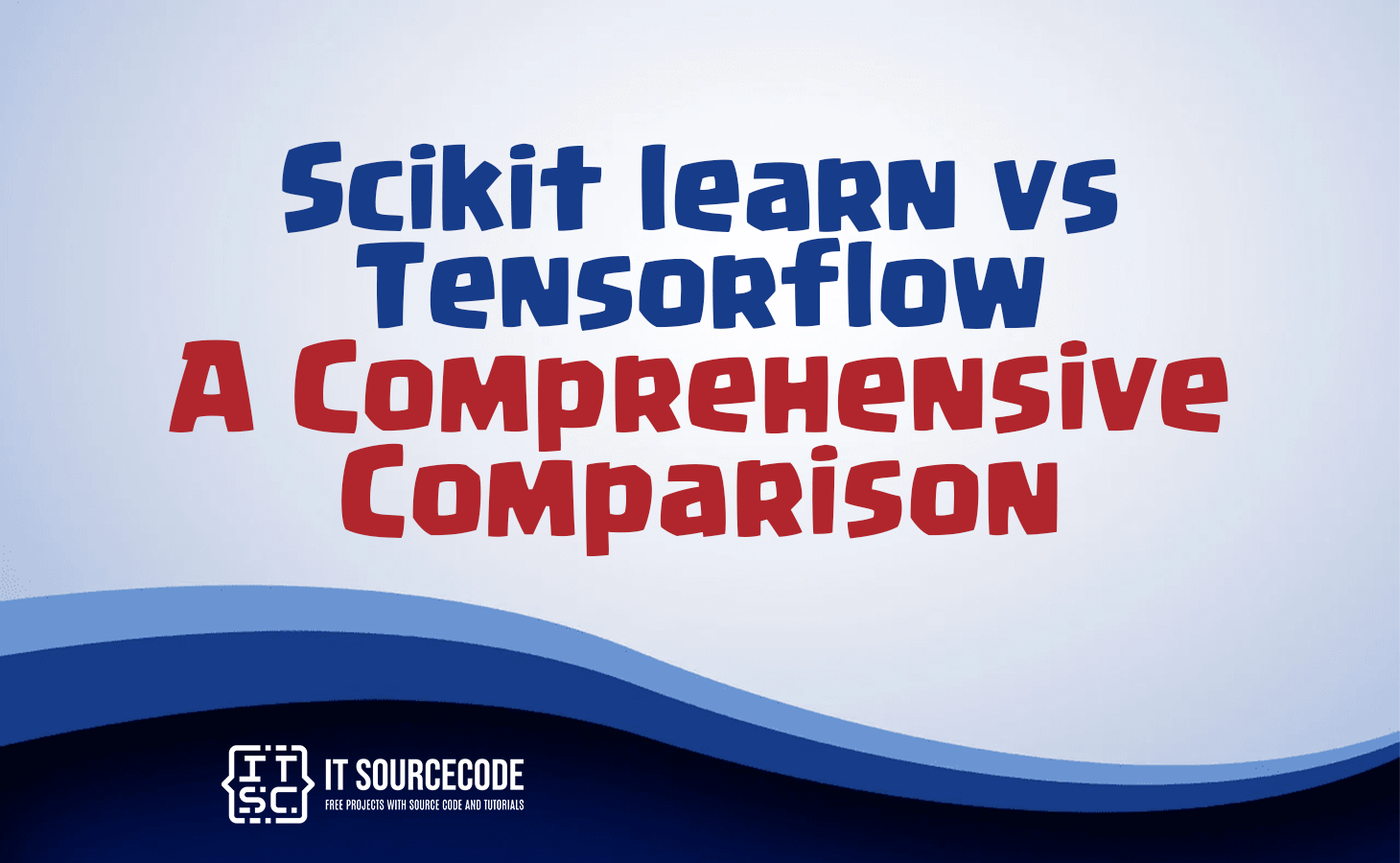SCIKIT LEARN VS TENSORFLOW | A COMPREHENSIVE COMPARISON – In this article, we delve into Scikit-learn, an open-source Python library offering a variety of supervised and unsupervised learning techniques.
Along with TensorFlow, a specialized open-source framework for prototyping and evaluating machine learning models, especially neural networks.

What is scikit learn?
Scikit-learn is a Python library available as open-source, offering an extensive collection of supervised and unsupervised learning techniques.
It streamlines the coding process by utilizing technologies such as Matplotlib, Pandas, and NumPy.
The library encompasses functionalities for selecting models, performing classification (including K-Nearest Neighbors), data preprocessing (including Min-Max Normalization), clustering (including K-Means++ and K-Means), and regression (including Logistic and Linear Regression).
To gain a better grasp of Scikit-learn, users can explore its applications, benefits, and drawbacks.
Features of scikit learn
Scikit-learn features:
- Model selection
- Classification
- Preprocessing
- Clustering
- Regression
Why Use scikit learn
Scikit-learn is a powerful library that enables us to define and compare various machine learning algorithms.
It provides tools for data preprocessing and includes a wide range of models such as K-means clustering, Random Forests, and Support Vector Machines.
Its main strength lies in its model assessment and selection capabilities, allowing us to cross-validate and perform hyperparameter searches to find the best model for our specific tasks.
Advantages and Disadvantages of scikit learn
Pros:
- Comprehensive API documentation on the scikit-learn website facilitates easy integration of algorithms with various platforms.
- Strong community support and frequent updates ensure the library remains current and reliable.
- User-friendly interface, making it easy to use for both beginners and experienced data scientists.
- Released under the permissive BSD license, offering free access with minimal legal constraints.
- Versatile and applicable to various real-world tasks, including neuroimaging and consumer behavior prediction.
Cons:
- Not ideal for those seeking in-depth learning or advanced customization.
- The simple abstraction might lead junior data scientists to skip learning fundamental concepts.
What is tensorflow?
TensorFlow is an open-source framework by Google for prototyping and evaluating machine learning models, including neural networks. It supports multiple languages and abstracts low-level numerical programming.
It is compatible with various operating systems, and the Google Cloud Machine Learning Engine can run TensorFlow models without traditional computing platforms.
Features of tensorflow
TensorFlow features:
- Open-source and flexible.
- Specialized in neural networks.
- High-level APIs for easy development.
- GPU support for faster computation.
- TensorBoard for visualization and debugging.
- Pre-trained models available.
- Automatic gradient computation.
Why Use tensorflow
TensorFlow is versatile, and suitable for neural networks and other methods using gradients like Boosted Trees.
It offers TensorBoard for model visualization. Its speed and optimization make it stand out, running efficiently on GPUs, CPUs, and TPUs.
Advantages and Disadvatages of tensorflow
Pros:
- Quick and easy mathematical expression calculations.
- Capable of generating various sequence models and training deep neural networks for tasks like handwritten digit classification.
- Unique memory and data usage optimization feature.
- Backed by Google, with regular feature releases, quick upgrades, and smooth performance.
- Works with different backend software (ASICs, GPUs, etc.) and is highly parallel.
- Strong and supportive community.
- Allows executing subparts of a graph, enabling discrete data introduction and retrieval.
- Superior computation graph visualizations compared to other libraries.
- Novel approach for tracking metrics and monitoring model training progress.
- Excellent performance is comparable to industry leaders.
- Scalable libraries are installed on hardware machines and connected devices.
Cons:
- Lacks usability and speed compared to some competitors.
- Limited GPU and language support (currently only NVIDIA GPUs and Python).
- Challenging handling of variable-length sequences.
- Limited compatibility with Windows environment, requiring alternative installation methods.
- Steep learning curve for beginners.
- No OpenCL support.
- Troubleshooting errors can be tough due to TensorFlow’s unique structure.
- Lags in computational speed for production environments.
- Not suitable for ultra-low-level system requirements.
- Requires a solid foundation in advanced mathematics, linear algebra, and machine learning, making it less beginner-friendly.
scikit learn vs tensorflow : Key Difference
| Tensorflow | Scikit learn |
|---|---|
| A neural network is employed to enhance the optimization process of TensorFlow. | Scikit-learn exhibits greater flexibility compared to other frameworks like XGBoost. |
| TensorFlow is employed during the design phase to aid developers and also for benchmarking new models. | Scikit-learn is utilized for both creating and benchmarking the new model, as well as providing support in its design and assisting developers. |
| TensorFlow is a library that operates at a low level, facilitating the implementation of various machine learning techniques and algorithms. | Scikit-learn, being a higher-level library, is also utilized for implementing the machine learning algorithm. |
| Although it is a third-party module, it enjoys broader usage. | Scikit-learn is another third-party module, but it is less popular compared to TensorFlow. |
| All of TensorFlow’s algorithms are implemented using the base class. | All algorithms in Scikit-learn serve as base estimators. |
| TensorFlow is a framework designed for deep learning. | Scikit-learn is predominantly used in diverse machine learning applications. |
| TensorFlow utilizes the neural network indirectly. | In practice, Scikit-learn is applied with a diverse set of models. |
| It offers specialized optimization under the hood, simplifying the comparison of neural network models and TensorFlow models. | Scikit-learn allows for the comparison of entirely different variations of machine learning models. |
| TensorFlow is a minimalistic neural network implementation. | Scikit-learn does not have a barebone implementation of a neural network model. |
FAQS
The choice between scikit-learn and TensorFlow depends on your specific needs and goals.
If you are new to machine learning or want to work on traditional machine learning tasks with a focus on simplicity and ease of use, scikit-learn is a good option.
On the other hand, if you are interested in deep learning, neural networks, and advanced machine learning applications, TensorFlow would be more suitable.
Yes, scikit-learn is generally considered easier to learn and use compared to TensorFlow.
Scikit-learn provides a simple and straightforward API that makes it easy for beginners and experienced users alike to quickly implement machine learning algorithms.
On the other hand, TensorFlow’s focus on deep learning and complex neural networks can make it more challenging for newcomers to grasp initially.
TensorFlow is preferred over scikit-learn when dealing with complex deep learning tasks, such as training deep neural networks for image recognition, natural language processing, and other sophisticated machine learning applications.
TensorFlow’s flexibility, support for GPUs and TPUs, and extensive capabilities in handling neural networks make it the go-to choice for deep learning projects.
Yes, scikit-learn remains widely used and popular in the machine learning community.
While TensorFlow and other deep learning frameworks have gained prominence, scikit-learn is still valued for its simplicity, ease of use, and wide range of traditional machine learning algorithms.
Many data scientists and machine learning practitioners continue to rely on scikit-learn for various tasks, especially when deep learning is not a primary requirement.
Additional Resources
- Kali Linux vs Ubuntu | A Comprehensive Comparison
- Does Software Engineering Require Math?
- How To Grow As A Software Engineer?
Conclusion
Scikit-learn, an open-source Python library, provides an extensive suite of supervised and unsupervised learning methods. It leverages technologies such as Matplotlib, Pandas, and NumPy to streamline the coding process. The library offers features including model selection, classification, preprocessing, clustering, and regression. By investigating its uses, advantages, and potential disadvantages, users can fully understand its capabilities.
TensorFlow, a Google-maintained open-source framework, specializes in prototyping and evaluating machine learning models, especially neural networks. It supports multiple languages, abstracts low-level numerical programming, and works on various operating systems. TensorFlow’s key features include high-level APIs, GPU support, TensorBoard for visualization, pre-trained models, and easy production deployment. The choice between the two depends on specific needs, with Scikit-learn valued for traditional ML tasks and TensorFlow excelling in deep learning and advanced applications.

